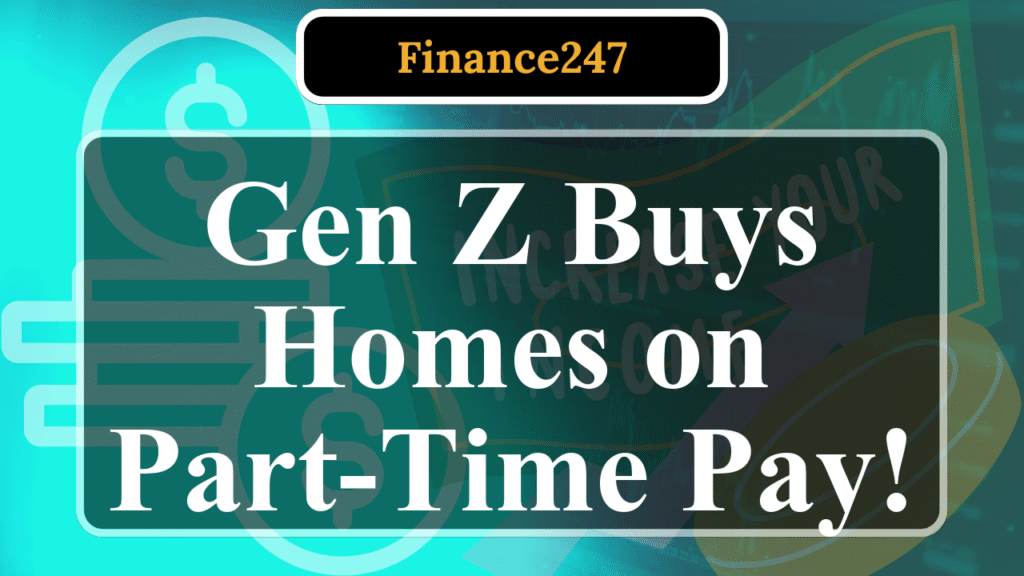“Gen Z faces a tough housing market, but some are saving for homes while working part-time. By budgeting, leveraging side hustles, and using high-yield savings accounts, young adults are making homeownership possible. This article explores practical strategies like cutting non-essential spending, utilizing FHA loans, and house hacking to achieve the dream of owning a home despite economic challenges.”
Gen Z’s Path to Homeownership on a Part-Time Budget
For Gen Z, born between 1997 and 2012, homeownership can seem like a distant dream, especially for those juggling part-time jobs in a high-cost housing market. Median U.S. home prices have soared to $410,000, according to the St. Louis Fed, while part-time workers often earn less than $20 per hour. Yet, some Gen Zers are defying the odds, saving diligently for a down payment while working limited hours. Here’s how they’re doing it.
Prioritize Budgeting and Track Spending
A disciplined budget is the cornerstone of saving for a home. Gen Zers like Mia, a 24-year-old coder from Denver, track every dollar using apps like YNAB or Mint. Earning $15 per hour working 20 hours a week, Mia nets about $1,200 monthly after taxes. By allocating 50% to essentials (rent, groceries), 20% to savings, and 30% to discretionary spending, she saves $240 monthly. Over two years, this adds up to $5,760—enough for a 3.5% down payment on a $165,000 condo with an FHA loan. According to a 2024 Rocket survey, 75% of Gen Z save regularly, with 10% targeting down payments, showing budgeting is key.
Cut Non-Essential Spending
To boost savings, many Gen Zers slash non-essential expenses. A Bank of America survey found 43% of Gen Z cut back on dining out, while 33% stick to grocery essentials. For example, Leo, a 26-year-old graphic designer, stopped frequent takeout and social drinking, saving $200 monthly. Thrifting clothes and canceling unused subscriptions like streaming services can free up another $50–$100 monthly. These small sacrifices add up, especially when part-time incomes are stretched thin.
Leverage Side Hustles for Extra Income
Side hustles are a game-changer for Gen Z. A 2024 Federal Reserve study notes 31% of Gen Z engage in freelance work, such as selling digital art or tutoring online, earning an average of $500 monthly. Alex, a 21-year-old retail clerk, earns $15 per hour part-time and supplements with $300 monthly from reselling vintage finds on Etsy. This extra income goes straight to a high-yield savings account (HYSA), where 5% annual yields help savings grow faster than traditional accounts offering 0.5%.
Maximize High-Yield Savings Accounts
High-yield savings accounts are critical for Gen Z savers. With interest rates still elevated after the Federal Reserve’s 2023–2024 hikes, HYSAs offer up to 5% APY, per Bankrate. For instance, saving $200 monthly in an HYSA at 5% yields an extra $125 annually through compound interest, compared to just $12 in a standard account. Mia uses an HYSA to stash her $240 monthly savings, projecting $6,200 after two years, including interest.
Explore FHA Loans for Lower Down Payments
FHA loans, requiring just 3.5% down, are a lifeline for part-time workers. For a $300,000 home, that’s $10,500—achievable with disciplined saving. Rocket’s 2024 survey shows 22% of Gen Z lack down payment funds, but FHA loans ease this barrier. Mia, with a credit score of 680, qualifies for an FHA loan, targeting a $350,000 condo. However, only 30% of Gen Z know closing costs add 2–5% ($6,000–$15,000 on a $300,000 home), per NAR 2024, so financial education is crucial.
House Hacking to Offset Costs
House hacking—buying a multi-unit property and renting out units—is gaining traction. Zillow reports 15% of Gen Z homeowners rent out rooms or build accessory dwelling units (ADUs), generating $800 monthly on average. Leo plans to buy a duplex, live in one unit, and rent the other to cover half his mortgage. This strategy turns homeownership into an income-generating asset, critical for part-time earners.
Co-Buying and Alternative Ownership Models
Co-buying with friends or family is another smart move. NAR’s 2024 data shows 12% of Gen Z pool resources for down payments, often splitting $20,000 deposits. Rent-to-own deals or shared equity programs, explored by 5% of Gen Z per Freddie Mac, allow locking in prices or trading cash for future equity. These creative solutions help navigate a market where 18% of Gen Z can’t find homes under $300,000, per Rocket.
Stay Educated and Avoid Pitfalls
Gen Z’s financial literacy is growing, with 45% using YouTube for finance tips, per Investopedia. However, misjudging home prices—81% of Gen Z estimate homes at $223,000, far below the $410,000 median—can derail plans. Avoiding high-interest debt is also critical; 27% of Gen Z carry more debt than savings, per Bankrate. By steering clear of “doom spending” on non-essentials, savers stay on track.
Real-Life Success Stories
Take Alex, who saved $10,000 in three years by combining side hustle income, thrifting, and an HYSA. He’s now pre-approved for an FHA loan on a $250,000 starter home. Similarly, Mia’s $8,000 savings, bolstered by her coding gig and budget discipline, positions her for a condo purchase by 2026. These stories highlight that part-time work doesn’t have to mean giving up on homeownership.
Disclaimer: This article is for informational purposes only and not financial advice. Consult a financial advisor for personalized guidance. Data sourced from St. Louis Fed, Rocket, Bank of America, Federal Reserve, Bankrate, NAR, Zillow, Freddie Mac, and Investopedia.


